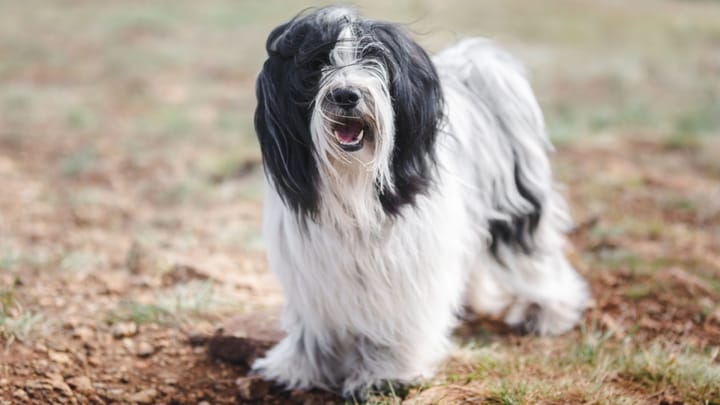Tibetan Terrier
Other names : Tsang Apso, Dhoki Apso


Despite his name, the Tibetan Terrier is not a terrier! He was originally used as a herding dog and watchdog before eventually falling into the companion dog category we are mostly familiar with today. Considered sacred in Tibet, he is much more lively than his Tibetan cousins hailing from the same group. Cheerful, docile and very smart, this little dog is perfectly suited for family life, which he takes great pleasure in and is very devoted to.
|
Life expectancy |
The Tibetan Terrier has a life expectancy of between 12 and 14 years |
|
Temperament |
|
|
Size |
Medium
|
|
Adult size |
Female
Between 14 and 16 in
Male
Between 14 and 16 in
|
|
Adult weight |
Female
Between 18 and 29 lb
Male
Between 18 and 29 lb
|
|
Coat colour
All colours are admissible (white, golden, grey, black, etc.) barring chocolate and liver. Parti and tri-coloured dogs exist. |
Black White Blue Red Sand |
|
Type of coat
The coat is long. The Tibetan Terrier sports a doublecoat: an abundant topcoat, of fine texture that is neither silky nor wooly, which can be straight or wavy, but never curly. The undercoat is thin and wooly. |
Long |
|
Eye colour
The eyes are a dark brown. |
Brown
|
|
Purchase price |
The Tibetan Terrier costs between £740 and £880 |
In Tibet, he was considered a sacred dog, and was indeed dubbed the ‘Sacred Dog of Tibet’.
More details about the Tibetan Terrier
Tibetan Terrier: Origins and history
His origins can be traced back to Tibet, where he gets his name from. The breed has since further developed in the United Kingdom. It is throughout the course of the 20th century that Dr. Agnes Greig imported the first specimens in Europe. The FCI officially recognised the breed in 1957.
Physical characteristics of the Tibetan Terrier
The Tibetan Terrier is slightly smaller than what would traditionally be considered a medium-sized dog, and has an abundant coat. His head is not massive but is certainly robust, with a short muzzle and a strongly built lower jaw. The eyes are big and round. The ears are ‘v-shaped’ and pendant, with a fringe. The frame is stocky and compact. The limbs are straight and muscular. The tail, of medium size, is cheerfully carried in a curl over the back.
FCI classification of the Tibetan Terrier
-
Group 9 - Companion and Toy Dogs
-
Section 5 : Tibetan breeds
Tibetan Terrier: Characteristics
Tibetan Terrier: Behaviour
Training a Tibetan Terrier
Even though he is quite calm by nature and possesses very little of the trademark Terrier characteristics, the Tibetan Terrier remains quite stubborn and demanding when it comes to commands, which he absolutely must perceive as coherent.
In short, he must feel like he understands the use of an order before deciding to cooperate. In this sense, a strict yet gentle handling is necessary, and must be initiated ahead of time to prevent the Tibetan Terrier pup from developing any bad habits.
Of course, the only viable way of working with him is through positive reinforcement, rather than submission and coercion.
Tibetan Terrier: Lifestyle
Breed compatibility Tibetan Terrier
Tibetan Terrier: Purchase price
The price of an Tibetan Terrier varies depending on its origins, age, and variety. You have to count an average of £880 for dogs subscribed to the Kennel Club.
With regards to the monthly budget required to meet the needs of a dog of this size, you have to estimate an average of £ 18 per month.
Tibetan Terrier: Shedding
Average
In contrast to many of his fellow canines, the Tibetan Terrier is generally only subject to one moulting season a year, during which brushes will need to be daily. Other than that, shedding is quite moderate.
Tibetan Terrier: Grooming
His long and abundant coat requires very regular, fastidious maintenance, so as to prevent knots from forming, and to preserve its beauty and protective properties.
His pendant ears also need to be checked and cleaned on a regular basis.
Tibetan Terrier: Health
Life expectancy is 13 years on average.
Extremely robust, the Tibetan Terrier tolerates difficult weather without a problem.
This dog is not fearful of heat, but he does need to be prevented from performing too intensely on hot days, and to be taken out for walks early in the morning and late at night.
His double coat contains a wooly undercoat which protects him from the cold, and from bad weather in general.
Very energetic, this little dog rarely gains excess weight. His intended weight must be maintained through a balanced diet. Physical exercise should not be overlooked simply because this dog is part of the companion and non-sporting group!
- Vascularisation of the retina
- Hip dysplasia
- Ear infections






